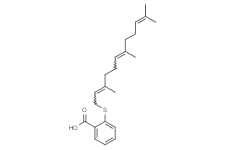
Salirasib
CAS No. 162520-00-5
Salirasib( Salirasib | Farnesylthiosalicylic acid | S-Farnesylthiosalicylic acid | FTS )
Catalog No. M18095 CAS No. 162520-00-5
Salirasib(Ki=2.6 μM), an effective competitive prenylated protein methyltransferase (PPMTase) inhibitor, inhibits Ras methylation with potential antineoplastic activity.
Purity : >98% (HPLC)
 COA
COA
 Datasheet
Datasheet
 HNMR
HNMR
 HPLC
HPLC
 MSDS
MSDS
 Handing Instructions
Handing Instructions
| Size | Price / USD | Stock | Quantity |
| 10MG | 43 | In Stock |


|
| 25MG | 87 | In Stock |


|
| 50MG | 146 | In Stock |


|
| 100MG | 210 | In Stock |


|
| 200MG | 345 | In Stock |


|
| 500MG | Get Quote | In Stock |


|
| 1G | Get Quote | In Stock |


|
Biological Information
-
Product NameSalirasib
-
NoteResearch use only, not for human use.
-
Brief DescriptionSalirasib(Ki=2.6 μM), an effective competitive prenylated protein methyltransferase (PPMTase) inhibitor, inhibits Ras methylation with potential antineoplastic activity.
-
DescriptionSalirasib is a salicylic acid derivative with potential antineoplastic activity. Salirasib dislodges all Ras isoforms from their membrane-anchoring sites, thereby preventing activation of RAS signaling cascades that mediated cell proliferation, differentiation, and senescence. RAS signaling is believed to be abnormally activated in one-third of human cancers, including cancers of the pancreas, colon, lung and breast.(In Vitro):Salirasib (12.5-100 μM) inhibits the proliferation of ELT3 cells in a dose-dependent manner with an average IC50 of 58.57±4.59 μM. The effects of Salirasib on the TSC2-null cells are evidently mimicked by DN-Rheb but not by DN-Ras. Salirasib reduces Rheb in TSC2-null cells and TSC2 expression rescues the cells from the inhibitory effect of Salirasib. Salirasib reduces phosphorylation of S6K but not of ERK in the TSC2-null ELT3 cells. Salirasib (50, 100, 150 μM) induces a dose- and time-dependent decrease of cell growth in HCC cells. Salirasib reduces cell proliferation through modulation of cell cycle effectors and inhibitors. Salirasib induces apoptosis in HepG2 and Hep3B cells. The growth inhibitory effect of salirasib in HCC cell lines is associated with mTOR inhibition independent of ERK or Akt activation. (In Vivo):Salirasib (40, 60 or 80 mg/kg, p.o.) significantly inhibits the tumor growth in a dose dependent manner in vivo. Salirasib (5 mg/kg, i.p.) significantly decreases Ras expression in the dy2J/dy2Jmice, and causes an increase in Ras expression which is by far much lower than the increase observed in the dy2J/dy2J mice. Salirasib treatment is associated with significantly inhibition of both MMP-2 and MMP-9 activities in the dy2J/dy2J mice. Salirasib (10 mg/kg, i.p.) inhibits tumour growth in a subcutaneous xenograft mice model without weight loss.
-
In VitroSalirasib (12.5-100 μM) inhibits the proliferation of ELT3 cells in a dose-dependent manner with an average IC50 of 58.57±4.59 μM. The effects of Salirasib on the TSC2-null cells are evidently mimicked by DN-Rheb but not by DN-Ras. Salirasib reduces Rheb in TSC2-null cells and TSC2 expression rescues the cells from the inhibitory effect of Salirasib. Salirasib reduces phosphorylation of S6K but not of ERK in the TSC2-null ELT3 cells. Salirasib (50, 100, 150 μM) induces a dose- and time-dependent decrease of cell growth in HCC cells. Salirasib reduces cell proliferation through modulation of cell cycle effectors and inhibitors. Salirasib induces apoptosis in HepG2 and Hep3B cells. The growth inhibitory effect of salirasib in HCC cell lines is associated with mTOR inhibition independent of ERK or Akt activation.
-
In VivoSalirasib (40, 60 or 80 mg/kg, p.o.) significantly inhibits the tumor growth in a dose dependent manner in vivo. Salirasib (5 mg/kg, i.p.) significantly decreases Ras expression in the dy2J/dy2J mice, and causes an increase in Ras expression which is by far much lower than the increase observed in the dy2J/dy2J mice. Salirasib treatment is associated with significantly inhibition of both MMP-2 and MMP-9 activities in the dy2J/dy2J mice. Salirasib (10 mg/kg, i.p.) inhibits tumour growth in a subcutaneous xenograft mice model without weight loss.
-
SynonymsSalirasib | Farnesylthiosalicylic acid | S-Farnesylthiosalicylic acid | FTS
-
PathwayOthers
-
TargetOther Targets
-
RecptorPPMTase
-
Research AreaCancer
-
Indication——
Chemical Information
-
CAS Number162520-00-5
-
Formula Weight358.54
-
Molecular FormulaC22H30O2S
-
Purity>98% (HPLC)
-
SolubilityDMSO : ≥ 50 mg/mL 139.45 mM; H2O : < 0.1 mg/mL
-
SMILESC(=O)(c1c(SC/C=C(\C)/CC/C=C(\C)/CCC=C(C)C)cccc1)O
-
Chemical Name2-(((2E,6E)-3,7,11-trimethyldodeca-2,6,10-trien-1-yl)thio)benzoic acid
Shipping & Storage Information
-
Storage(-20℃)
-
ShippingWith Ice Pack
-
Stability≥ 2 years
Reference
1. Marciano D, et al. J Med Chem. 1995, 38(8), 1267-1272.
molnova catalog



related products
-
Lucidumol A
Lucidumol A has relatively good effect against aldose reductase with IC50 of 19.1uM. Lucidumol A has cytotoxic activity, it reduced cell growth in three human carcinoma cells (Caco-2, HepG2, and HeLa cells) dose dependently with LC50s from 20.87 to 84.36 uM.
-
Delphinidin-3-sambub...
Delphinidin-3-sambubioside chloride has antioxidant activity.
-
(22S,23S)-Homobrassi...
(22S,23S)-Homobrassinolide induces plant growth in various plant bioassay systems.



 Cart
Cart
 sales@molnova.com
sales@molnova.com


